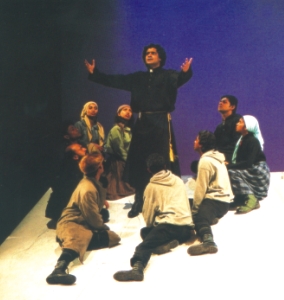|
Theatre
Moments of Drama in Stills
Sabira Manir
 The importance of our theatre cannot be emphasised enough. Bangladeshi theatre has earned a fair amount of commendation largely due to a few individuals who have selflessly dedicated to the development of theatre. The importance of our theatre cannot be emphasised enough. Bangladeshi theatre has earned a fair amount of commendation largely due to a few individuals who have selflessly dedicated to the development of theatre.
Kamal Uddin Kabir who lives for theatre. He is passionate about directing, often designing the sets when necessary. It's natural that he would have a particular interest about theatre. Ten years ago he came up with the idea that the plays staged in the theatre should be preserved in photographs. So, he chose photography. At some point he discovered that the still photography of those theatre-moments has been able to draw people's attention. He came to realise that those who are already in Proscenium or are about to enter the field of theatre have got to witness those theatre-moments as still photography. He expects that these photos will shed light on the theatre practice of today and will cater to the thinking process of future theatre-activists.
In order to realise his dream, Bengal Shilpalay arranged an exhibition inaugurated on July 3. Noted artiste Mustafa Monwar inaugurated the event, Wolfgang Vollaman, UNESCO representative in Bangladesh was present as the special guest.
Theatre activists, drama teacher, set designer and director Kabir has been photographing stage performances, both in the city and in villages for over ten years. The photographs not only highlight urban theatre but also folk theatre performances, such as Palagan, Satya Pirer Gan, Manasha Mangal, Alkap and more.
About his work, Kabir says, “At the end of any theatrical production, we are left only with memories of the stage. To get an overall impression of the production, documentation is a must. Theatre photographs reflect whether compositions were complete or not. Through photographs we can get a complete idea of the discourses delivered though movements on the stage. A photograph keeps the productions alive even after years of its staging.”
The photographs in the exhibition are far more effective than words could be. Every image is bustling with life, energy and a brilliant display of light shadows. All have their own stories to tell. Kabir's pictures don't high light the face of a performer. Kabir rather focuses on the totality of presentation. He likes to take in the whole ambience of the stage and capture the drama, the dynamism and the depth of a particular moment. Kabir does not only focus on the stage. His camera often zooms on the faces in the audience. In his photographs the members of the audience are not just onlookers; they are active elements in the total scenario of a theatre production.
The photographs of Kabir's solo exhibition bring together a diverse range of theatre activities group theatre plays, academic work by the theatre departments of our universities and folk performances. These have all been shot in action while the performances were going on. The photographs are therefore moving, as against frozen images of our theatre.
Despite a positive response of the exhibition from the audience, Kabir adds, “Arranging photo exhibitions only are not going to serve the whole purpose of the endeavour. Apart from this, organisations like Group Theatre Federation, Bengal Shilpalaya can publish Albums of Thetre Photography.”

In future, Kabir wants to arrange an exhibition focusing the folk drama mainly because he thinks that the techniques of all performances have evolved from folk drama. Therefore if we can uphold and nurture the basic elements of folk drama, we can upgrade our modern theatre. “Theatre photography should be encouraged and considered essential in the total theatrical culture” Kabir asserts. Copyright (R) thedailystar.net 2006 |
